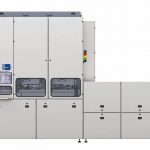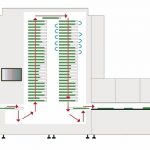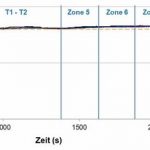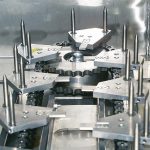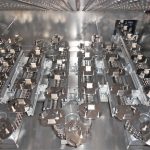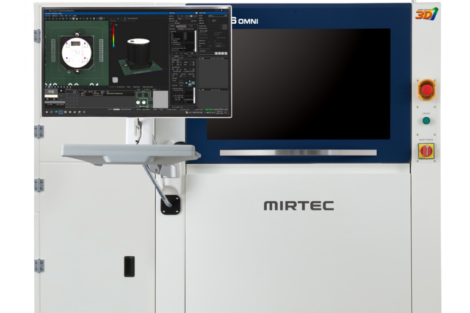The headlights of a car ensure a safe journey day and night; the vehicle airbag saves lives no matter the conditions; the onboard computer and sensors in an aircraft provide reliable measurements, even at an altitude of 10 kilometres, to safely guide the aircraft in the sky and bring it back to the ground. Behind each one of these functions is a myriad of highly complex electronic assemblies and connections, which are produced using a dryer.
In order to ensure the reliability of these sensitive electronic assemblies, even in the harshest environment, a coating layer is applied to the assembled circuit boards and then cured in a special drying system. The coating protects sensitive electronic components from damage through corrosion or other environmental influences, such as humidity, chemicals or dust. Additionally, it greatly increases the service life and quality of the product. Alternatively, complete assemblies can be potted and encapsulated. The company offers innovative drying and curing processes to suit any demands in this field – such as the vertical drying system Alteco, as well as a dryer that meanders horizontally or a continuous dryer that guarantees optimal drying and curing results thanks to reliable vertical looped transport system (Pramo).
Vertical dryer
One of the company’s latest developments is the vertical drying system Alteco, which offers maximum performance with minimum space requirements. All industries that utilise coating processes and work with sensitive flat assemblies with protective coating benefit from this system. In addition to the best temperature profiling possibilities and low energy consumption, the minimum space requirement was also successfully achieved in the implementation of this system. Thanks to vertical transport, the Alteco replaces a comparable 40-metre-long horizontal dryer with a system length of just 4 metres. With this innovative system concept, valuable space in the production hall can be saved, existing resources can be optimally used, and daily production can be optimised. Two process towers can be arranged according to the vertical stacking principle. The system is equipped with appropriate drip protection mechanisms in order to avoid soiling of the mechanics and undesirable contamination of the assemblies with e.g. coating drops.
An important aspect for every manufacturer of highly complex electronic assemblies is the flexibility of the equipment used. The company’s vertical drying system enables flexible, high-performance drying and curing processes for all protective coatings and casting compounds that can be cured with convection heat. In the furnace inlet the PCBs are loaded onto product carriers. These pass through the drying process in the system in a vertical direction and are stacked on top of each other during the curing process. The actual drying process is carried out in two process towers, which are each divided into several heating zones.
The downstream, segmented cooling section ensures gentle and uniform cooling of the assemblies for subsequent production stages. Alternatively, the cooling section can also be integrated into the vertical system. This principle is ideally suitable for assemblies that require shorter process throughput times due to their lower mass, or which are not processed directly afterwards and can therefore cool down in downstream magazines.
Two transport variants are available for the Alteco vertical dryer. Firstly, a fixed transport width in which the circulating product carriers are set to a fixed position, and secondly, a flexible transport width in which the circulating product carrier transport automatically adjusts to the respective assembly size. This allows simultaneous drying of different coated boards or boards of different sizes. This means that several coating lines can feed different products with a mix of different PCB transport widths to the Alteco. This is specially designed for the drying process of flat assemblies with a maximum height of 50 mm.
A drying or curing process must meet important requirements. There are particular parameters, such as the maximum temperature, the process duration at this temperature, the temperature deviation from the maximum temperature, and the temperature homogeneity, e.g. over the entire surface of the goods carrier. As an example, a temperature profile for drying potted assemblies was created. For this application, a process time of 40 minutes was achieved at 80 °C. In addition, the profile only exhibits a small fluctuation in the temperature tolerance.
The heating system based on the convection principle under air is the basis for this optimal temperature profiling. In order to react to temperature fluctuations as flexibly as possible, temperature and volume flow can be set separately in all heating zones. In addition, a specially developed air duct guarantees uniform heating of all assemblies. The exhaust air volume is also controlled separately for each zone. Thus, the system can be optimally adjusted to the amount of coating and the solvent throughput.
Meander system
Vertical dryers save space on the surface, but require sufficient height clearance in the production facilities. In addition, the natural thermals in a vertical process chamber are crucial for the process, as heat always rises. If very small tolerances in the reproducibility of the temperature-time profile are required, it may be technically more sensible to thermally process the products in a horizontal process chamber.
With the RDS 45000 meander system, the company has developed a special solution that enables equally long product dwell times at a productivity of 3.5 units/min in a horizontal position. The products meander in 13 tracks through the process chamber, which has a maximum temperature of 130 °C and is equipped with 18 heating zones. The goods carrier transport can be loaded either manually or automatically, but always according to the first-in-first-out principle. The position of loading and unloading is variable.
The meander system also features seamless traceability: the barcode of the individual assembly is read in, which enables an exact assignment of the process-related data. The time stamps for loading and unloading, as well as the heating temperature in the furnace or a single zone are also included. The supply air of the meander dryer is on one hand preheated by the reverse flow process and on the other filtered by a filter monitoring system. Due to the fact that each part runs through the same process, the system has high reproducibility. It is available in an oxygen or nitrogen model. A cooling section can be optionally integrated. However, if a cooling section is integrated, it can be ordered in an air-cooled or water-cooled model.
Continuous dryer
In the continuous dryer Pramo, the assemblies are transported through the system on goods carriers with “shuttle” supports. Within the dryer, they pass through several zones in which they are heated up to the appropriate temperature and then maintained at the set temperature for the drying/hardening process. The maximum temperature in the dryer is 150 °C.
In order to harden the materials according to the specifications, the cycle time can be adjusted according to the necessary dwell time of the assemblies in the drying system. The flexible goods carrier receptors are interchangeable, which means various assemblies and also special forms can be guided safely and reliably through the system at any time. The Pramo offers flexibility and security in the design and implementation of your testing tasks, also with regard to warm function testing. A stable circular product carrier transport ensures absolute process stability and safe transport of the assembly through the system. This gives the system sufficient capacity to reliably adhere to the desired test temperature, even when processing large parts in a short cycle time. In order to guarantee the removal of the assemblies at the appropriate temperature, the product carrier return is designed as an additional heating zone.
A robot or handling system loads and unloads the assemblies into the product carriers. The gondolas/carrier boats are equipped with a clamping unit for automatic loading with a robot. Manual loading and unloading can be an alternative. The transport is carried out in loops in order to achieve the longest possible throughput times and process a high number of units. This reduces the surface area, as well as the height of the system, and saves space in the production facility.
Depending on the number of product carriers, the Pramo is available as a 2-, 3-, or 4-looped transport. With a maximum size of 1520 x 200 mm, the size of the goods carriers is identical in each of the available models. However, the number of goods carriers in the system varies between 27 and 58. The assemblies for downstream processes are cooled in the cooling section. This allows immediate further processing of the assemblies. Cooled air is blown onto the carrier with the assembly in each segment. The waste heat is transferred to the incoming fresh air via a heat exchanger and thus removed from the production room in an energy-saving way. Alternatively, a residual management system with two cooler/filter units for cold condensation is available instead of the heat exchanger.
The cooler and filter units can be easily cleaned in an ultrasonic bath for maintenance purposes. If the parts are unloaded warm as part of a warm function test, the return line can be run as an additional heating zone. A measuring cable with prepared parts and a memory meter can be easily used via a quick-release fixing. The system is controlled by software via a touchscreen user interface. All relevant process parameters such as throughput time and temperature are documented via a barcode on the product carrier gondola and, if necessary, transferred to an MES system. SMEMA interfaces allow the integration of the system into any production line.
A variety of basic physical principles of heat transfer are used and many technical designs are implemented to make drying processes as efficient as possible. Day by day, Rehm rises to the challenge of converting innovative technologies into series production-ready systems and can help to evaluate the optimum technology parameters with the customer, during the conception phase.
SMTconnect, Booth 4A-100
Info box
The application or the product to be produced, as well as the expected throughput in production, determine the technical configuration of the dryer. In photovoltaics, for example, a throughput of = 1.5 seconds per wafer is standard, which places particular demands on the transport system. On the other hand, long dwell times are not unusual when tempering products. In order to achieve this with as little space as possible for the dryer, the room-height vertical dryers use the third dimension, or meander dryers run horizontally through the thermal system in loops at low speed.
Solvents and additives are added in order to improve the handling of coatings and casting compounds. However, these solvents must be removed after coating or casting. Otherwise the protective layers are unable to dry. The volatile components of the solvents escape from the coating and casting material, even at room temperature. One long-established way of accelerating this process is to apply heat to the assemblies. The increased temperatures lead to faster curing reactions according to the Arrhenius law. The coated assemblies can be heated either by convection and/or IR radiation. These seemingly simple and long-established physical principles, however, present new challenges in systems engineering when combined with complex requirements such as high throughput, energy efficiency, homogeneous temperature distribution and flexibility. Other factors not directly related to process engineering must also be taken into account, such as space constraints in production facilities. In such cases, only the “upwards escape” remains, which isn’t a problem with the Alteco vertical drying system.
Manufacturers of electronic assemblies are always confronted with the challenge of focusing on the efficiency of the entire production chain, short lead times and tight set-up times. However, the reliability and quality of the manufactured assemblies must be guaranteed 100 %. By using innovative control, fan, heating and sensor components combined with a solid construction, the company delivers high-quality systems with which stable processes can be run reproducibly in every production. The application specialists can determine the optimum setting parameters for a corresponding assembly manufacturing. In-house training, as well as process and maintenance training in the respective production environment, complete the range of services offered by the company.
Zusammenfassung
Um die Zuverlässigkeit empfindlicher elektronischer Baugruppen auch unter härtesten Bedingungen zu gewährleisten, wird eine Beschichtungsschicht auf die bestückten Leiterplatten aufgebracht und anschließend in einem speziellen Trocknungssystem ausgehärtet. Im Mittelpunkt des Artikels stehen innovative Trocknersysteme und -verfahren für alle Anforderungen.
Résumé
Afin d‘assurer la fiabilité des assemblages électroniques sensibles, même dans les conditions les plus difficiles, une couche de revêtement est appliquée sur les cartes de circuits imprimés assemblées, puis durcie dans un système spécial de séchage. L‘article se concentre sur des systèmes et des procédés de séchage innovants pour satisfaire toutes demandes.
Резюме
Для обеспечения надежного функционирования чувствительных электронных узлов в самых суровых условиях эксплуатации на укомплектованные платы наносится слой защитного покрытия, отверждаемого в специальной системе сушки. В статье рассказывается об инновационных системах и методах сушки, удовлетворяющих различным требованиям.


